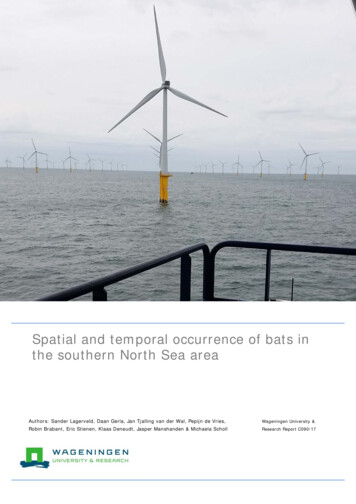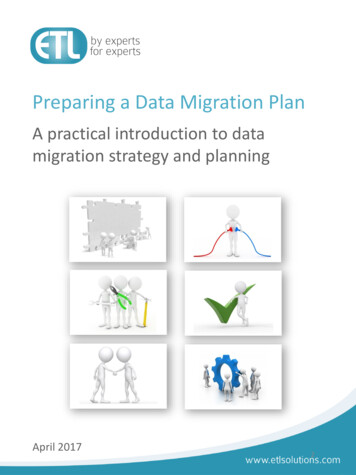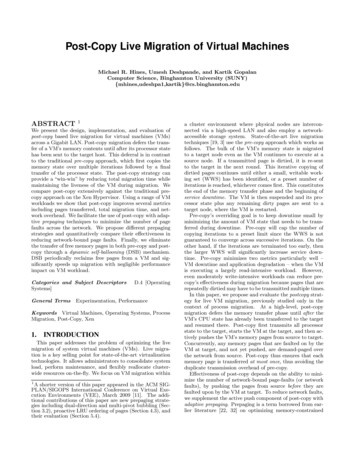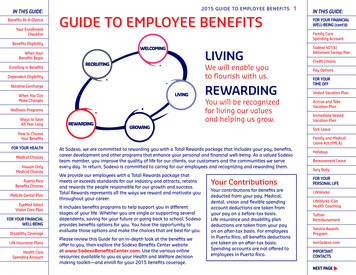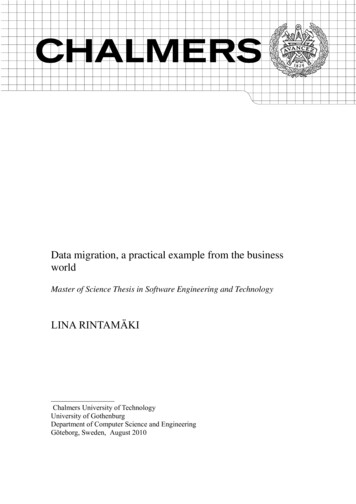
Transcription
Unit Title: Migration Vacation in Mexico:Bats, Sea Turtles, and Butterflies on The MoveAuthor: Robi ParkerSchool: Arrow Springs Elementary SchoolBroken Arrow, OklahomaSubject Area: Science and Social StudiesTopic: Bats, Sea Turtles, and Butterflies in MexicoGrade Level: K–2Time Frame: 3–4 WeeksBrief Summary: Students will learn about three species of animals (mammals –bats; reptiles - sea turtles; and insects - butterflies) that spend a portion of theirlives living in Mexico. The Bat Unit will give a general overview of bats. The SeaTurtle Unit will focus on the seven species of sea turtles found in Mexico and theButterfly Unit will focus specifically on the monarch butterfly. The goal of thisstudy is to familiarize young children with the process of migration, enrich theirknowledge about three different types of animals found in Mexico, and help themto learn more about the conservation efforts that are helping those animals.Established Goals: Oklahoma PASS SkillsScience Objective 7: Discuss how hibernations, migration, and camouflageare ways organisms increase their survival.Science Objective 14: Illustrate that plants and animals have differentstructures that help them live in environments such as air, water, or land.Science Objective 16: Demonstrate that plants and animals have life cyclesthat include developing into adults, reproducing, and eventually dying. Thedetails of this life cycle are different for different organisms.Science Objective 17: Discuss that animals have different structures thatenable them to function in their environment (e.g., feathers for flight, shellfor protection).
Migration Vacation in Mexico:Bats, Sea Turtles, and Butterflies on the MoveBatsParker – Migration Vacation in Mexicop. 2 of 2
Desired Results for BatsUnderstandings: Students will understand what bats look like, how bats live, whatthey eat, and where they live. They will learn about many different species of batswith an emphasis on the Mexican free-tailed bats.Central Questions:Where do bats live?Are bats really blind?What do bats like to eat?Are bats helpful or harmful?What type of animals are bats?What do different species of bats look like?Why don’t we see bats flying during the daytime?Students will know:Bats are mammals.Bats are nocturnal.Bats live all over the world.Body structure of the bat.Bats are important to the ecosystem.Bats use echolocation to fly in the dark.There are more than 900 species of bats.Different species of bats feast on various types of foods such as insects,fruit, fish, frogs, and even blood.Students will be able to:Tell how bats help the ecosysyem.Identify the main body parts of the bat.Distinguish facts from opinions about bats.Understand how mother bats recognize their own babies.Identify Mexican free-tailed bats and understand their migration patterns.Parker – Migration Vacation in Mexicop. 3 of 3
Assessment EvidencePerformance Tasks:1. Students will give an oral report on bats at the end of the unit.2. Students will label the main body parts of a bat.3. Students will play a game in which they must accurately locate “their” babybat using only their sense of smell.Other Evidence:1. Students will draw and write about bats in science journals.2. Students will be able to locate migration patterns between Southern Texasand Mexico on a map.3. Students will describe orally the time of year Mexican free-tailed batsmigrate and the reasons why they migrate.Parker – Migration Vacation in Mexicop. 4 of 4
Day One: Assessing Background KnowledgeMaterials: Chart paper, marker, book with facts about bats (see book list)Time: 30 minutesLesson: Use chart paper to complete a K/W/L chart. Ask the students what theyalready know about bats. Accept all answers even if they are incorrect. Recordanswers on a large sheet of chart paper. Next, ask students what they would liketo learn about bats. Be sure to include questions about hibernation and migration.Record these questions on a second sheet of chart paper. Post these chartssomeplace in the room as they will be used again at the end of the unit. Completetoday’s lesson by reading one of the books about bats. I like to read Big Brown Batby Rick Chrustowski.K/W/L ChartWhat I KnowWhat I Want to KnowWhat I Learned‘Parker – Migration Vacation in Mexicop. 5 of 5
Day Two: What is a Bat?Materials: Bats! by the Editors of TIME For Kids, chart paper, student’s sciencejournalsTime: 30 minutesLesson: Gather students into a large group. Tell students that we will be reading anon-fiction book about bats. Remind them to be listening for real facts about bats.Read the book. Ask kids to tell about what they just learned about bats, recordanswers on chart paper.Facts from the book:Bats are nocturnal.Bats are mammals (they have fur and drink milk from their mothers).Bats are the only mammals that can fly.Baby bats are called pups.Pups learn to fly when they are only one month old.At a year old, a pup is all grown up.Bats live in homes called roosts.Bats live all over the world except where it is very cold.Some bats eat fruit and flowers, some eat meat, some drink blood, but mostbats eat insects.Bats have a special sense called echolocation.Humans are the biggest threats to bats.Bats are helpful because they eat insects, pollinate flowers, and spreadseeds.Texas is home to the most bats in the United States.Activity: Have students return to their seats and draw a picture in their sciencejournal of what a bat does in the daytime and what a bat does in the nighttime.Have them record this sentence: Bats are nocturnal. (Assess journals to verifyunderstanding.)Parker – Migration Vacation in Mexicop. 6 of 6
Day Three: Amazing Bat Bodies!Materials: several pictures of various species of bats, Bat Body worksheet mmals/bat/label/external/)Time: 30 minutesLesson: Show students pictures of lots of different bat species. Ask, “What dothese bats have in common?” Explain that a bat’s wings are thin sheets of skinthat are stretched between their fingers. Good Visual: Have students stretchtheir hands out with their thumbs pointing up and fingers moving freely in alldirections. A bat can move its fingers in much the same way so it can easily changeits wing shape to turn, hover, and do flips.Activity: Complete the Bat Body Worksheet. Insert it into science journal.Parker – Migration Vacation in Mexicop. 7 of 7
Day Four: Where do Bats Live?Materials: World Map, Map of North America, Map of Southern USA and Mexico(from: printout.shtml )Time: 30 minutesLesson: Use the world map to discuss that bats live all over the world except invery cold areas. The background knowledge below will help you lead the discussion.Wrap up the discussion by reading Batty about Texas by J. Jaye Smith; illustratedby Kathy Coates. It is an illustrated discussion of the Mexican free-tailed bat,which lives all over Texas, particularly in Austin where the largest urban bat colonyexists beneath a bridge, and covers how the bats contribute to tourism, fertilizerfor farmers, and mosquito control in the region. Use the map of North America tohelp students find Austin, Texas and Mexico. Discuss how the bats migrate toMexico as the weather turns cooler in the fall, around November, and return againin the spring, around May. Show pictures of bats in Austin and at a cave nearCalakmul, Mexico.Activity: Students will color a map of Southern USA and Mexico. Insert it intoscience journal.Background Knowledge: Bats are found on every continent except Antarctica.There are over 950 species of bats. There are about 45 different species of batsliving in the United States. Mexico is home to about 140 different species of bats.Most bats live in large groups called colonies. There can be thousands of bats in acolony. Bats generally live in caves, old mine tunnels, under rocky areas, treehollows, under bridges, or in the walls and roofs of buildings. Bats that live inareas with cold winters will either hibernate or migrate to warmer temperatures.In Austin, Texas, a colony of Mexican free-tailed bats summers (they winter inMexico) under the Congress Avenue Bridge ten blocks south of the state capitol.It is the largest urban colony in North America with an estimated 1,500,000 bats.Each night they eat millions of insects. When their food supply dwindles in thefall, they fly to warmer weather in Mexico where there is a greater supply of theirfavorite food: insects.Parker – Migration Vacation in Mexicop. 8 of 8
Pictures taken at Congress Avenue Bridge, Austin, TexasParker – Migration Vacation in Mexicop. 9 of 9
Pictures taken at a cave near Calakmul Bio-Reserve, Campeche,MexicoParker – Migration Vacation in Mexicop. 10 of 10
Day Five: Are You My Baby?Materials: Book with facts about bat nurseries, cotton balls soaked in variousscents (perfume, vanilla extract, liquid smoke, orange extract, cinnamon, etc.),blindfoldsTime: 30 minutesLesson: Read to students about bat nurseries. (See background knowledge below.)Divide the class into 4 groups. Spread the groups into separate locationsthroughout the classroom. Give each group member a different scented cottonball. Choose one group to be the mothers. Blindfold the mothers and have them goto the first group of students. Each mom will have to identify their baby by thescent of their cotton balls. Check to see that all babies and mothers werematched up correctly. The first group of students then become the mothers andthey will go to the second group and find their babies. Continue until all studentshave had a chance to be the .16.17.18.19.20.Scent 1XXScent 2XScent 3XScent 4XXXXXXScent 5XXXXXXXXXXParker – Migration Vacation in Mexicop. 11 of 11
Day Six: Preparation for Oral ReportMaterials: Book with facts about bats, poster board, markersTime: 45 minutesLesson: Divide students into small groups. Allow them time to prepare a posterthat gives facts they learned about bats during this unit. Be sure to have lots ofbooks available for them to use to hunt for additional facts. They will need to havean illustration of a bat on their poster identifying the major body parts.Day Seven: Oral Report – Culminating ActivityMaterials: Posters prepared by students on Day 6.Time: 30 minutesLesson: Groups of students will give an oral report on bats while displaying theposter they made yesterday. Be sure to complete the KWL chart begun on Day 1.Poster - ContentIncluded 1–3 accuratefacts about bats1 Point2 PointsPoster - VisualPoster lacks importantinformation or isvisually sparsePoster includesrequired informationand is visually appealingOral PresentationPresentation isunorganized and lacksthe basic informationabout batsGroup members did notwork together andoften argued or wereoff-taskPresentation isorganized and has mostof the basicinformation about batsGroup members workedwell together most ofthe time and wereusually on taskGroup ParticipationIncluded 4–7 accuratefacts about bats3 PointsIncluded 7 or moreaccurate facts aboutbatsPoster includes morethan the requiredinformation and isvisually appealingPresentation isorganized and has allthe basic informationabout batsGroup members workedwell together most ofthe time and werealways on taskParker – Migration Vacation in Mexicop. 12 of 12
BibliographyChrustowski, Rick. Big Brown Bat. New York, NY: Henry Holt and Company, c2008.Davies, Nicola. Bat Loves the Night. Cambridge, MA: Candlewick Press, c2001.Earle, Ann. Zipping, Zapping, Zooming Bats. New York, NY: HarperCollins, c1995.Gibbons, Gail. Bats. Bronx, NY: Holiday House, 1999.Iorio, Nicole. Bats!, by the Editors of TIME For Kids. New York, NY: HarperCollinsPublishers Inc., 2005Kalman, Bobbie. Endangered Bats. New York, NY: Crabtree Publishing Company, 2006.Lies, Brian. Bats at the Beach. Boston, MA: Houghton Mifflin, c2006.Lies, Brian. Bats at the Library. Boston, MA: Houghton Mifflin, 2008.Markle, Sandra. Little Lost Bat. Watertown, MA: Charlesbridge, 2006.Markle, Sandra. Outside and Inside Bats. New York, NY: Atheneum Books For YoungReaders, 1997.Mason, Adrienne. Bats. Tonawanda, NY: Kids Can Press Ltd., 2003.McNulty, Faith. When I Lived with Bats. New York, NY: Scholastic, c1998.Perry, Phyllis. Bats, The Amazing Upside-downers. Danbury, CT: Franklin Watts, 1998.Shebar, Sharon Sigmond. Bats. New York, NY: Franklin Watts, 1990.Smith, J. Jaye. Batty about Texas. Gretna, LA : Pelican Pub., 2009.Stout, Frankie. Bats, Nature’s Night Flyers. New York, NY: PowerKIDS Press, 2009.Bat Web sites:Bat Conservation International: http://www.batcon.org/Bat Facts and Amazing Trivia: http://www.letsgetwild.net/docs/bats.pdfParker – Migration Vacation in Mexicop. 13 of 13
Migration Vacation in Mexico:Bats, Sea Turtles, and Butterflies on the MoveSea TurtlesParker – Migration Vacation in Mexicop. 14 of 14
Desired Results for Sea TurtlesUnderstandings: Students will understand what sea turtles look like, how seaturtles live, what they eat, and where they live. They will learn specifically aboutthe seven species of sea turtles that live in the Caribbean.Central Questions:Where do sea turtles live?What do sea turtles like to eat?What kind of animals are sea turtles?What is the life cycle of a sea turtle?What do different species of sea turtles look like?Students will know:Sea turtles are reptiles.The leatherback turtle is the largest reptile in the world.Sea turtles have lived on earth for over 100 million years.Nesting females usually return to the beaches where they were born to laytheir own eggs.There are seven species of sea turtles.Male sea turtles rarely return to land.Sea turtles can live to be 100 years old.Sea turtles are found in warm oceans around the world.Mother sea turtles can lay as many as 500 eggs in one season.Mother sea turtles usually return to the beaches where they were born tolay their eggs.Students will be able to:Identify the main body parts of the sea turtle.Distinguish facts from opinions about sea turtlesRecognize the physical characteristics of different sea turtle species.Role-play the chain of events between the time that the mother sea turtlecomes ashore and lays her eggs to the time when the hatchlings return tothe sea.Parker – Migration Vacation in Mexicop. 15 of 15
Assessment EvidencePerformance Tasks:1. Students will give an oral report on sea turtles at the end of the unit.2. Students will label the main body parts of a sea turtle.Other Evidence:1. Students will draw and write about sea turtles in science journals.2. Students will be able to locate migration patterns between the northernAtlantic Ocean to the Gulf of Mexico on a map.3. Students will describe orally the major threats to sea turtles and theconservation efforts that are underway in the U.S. and Mexico.Parker – Migration Vacation in Mexicop. 16 of 16
Day One: Assessing Background KnowledgeMaterials: Chart paper, marker, book with facts about sea turtles (see book list)Time: 30 minutesLesson: Use chart paper to complete a K/W/L chart. Ask the students what theyalready know about sea turtles. Accept all answers even if they are incorrect.Record answers on a large sheet of chart paper. Next, ask students what theywould like to learn about sea turtles. Be sure to include questions about migration.Record these questions on a second sheet of chart paper. Post these chartssomeplace in the room as they will be used again at the end of the unit. Completetoday’s lesson by reading one of the books about sea turtles. I like to read Intothe Sea by Brenda Z. Guiberson.K/W/L ChartWhat I KnowWhat I Want to KnowWhat I Learned‘Day Two: Sea Turtles and NestingParker – Migration Vacation in Mexicop. 17 of 17
Materials: The Life Cycle of a Sea Turtle by Bobbie Kalman, large plastic container,sand, 100 ping pong balls, replica of a large sea turtle, journal, crayons, pictures ofsea turtlesTime: 30 MinutesActivity: Remind students of the book we read yesterday (Into the Sea by BrendaZ. Guiberson). Have them brainstorm some of the facts from the story. Rereadthe following paragraph:“After more than twenty years in the sea, the turtle returns to the land. She waitsuntil nighttime, when the tide is high, to come in. She is slow and awkward as she pulls herhuge body up onto the sandy beach. She does not see well on land. Tears stream down hercheeks, as they do in the water, to help her body get rid of extra salt from the sea. Shepokes her nose into the sand. The turtle seems to know that she has come back to thesame island where she was born.”Simulation Day 1: After a discussion about sea turtles returning twenty yearslater to the same beach where they were born to lay their eggs, begin thesimulation. Bring out a large plastic storage container (about 2’ by 3’). Pour in sanduntil the container is half full. Now, dim the lights to simulate night time. Waitpatiently for a mother sea turtle to appear. (I use a large plastic sea turtle but astuffed animal would work well too.) Place her on top of the sand. Read p. 12–13 ofThe Life Cycle of a Sea Turtle by Bobbie Kalman. It describes the nesting processin a way that is easy enough for first graders to understand. Dig a large hole inthe sand then pour in 100 ping pong balls. Read p. 14 of the same book. It is abouthow the mother sea turtle leaves her eggs and returns to the sea. Cover the eggs(ping pong balls) with sand using the mother sea turtle to act it out. Explain to thekids that the mother now swims out to sea knowing that her babies willinstinctively know what to do when they hatch in 45–70 days. Cover the containerfrom student’s view.Activity: Color a picture of a sea turtle and journal about the nesting process.Use the following vocabulary words: egg chamber, nesting, and clutch. Seeglossary for definitions.Parker – Migration Vacation in Mexicop. 18 of 18
Day Three: Types of Sea TurtlesMaterials: pictures and information about sea turtles, map of the Caribbean,butcher paper, yard stick, markerTime: 30 minutesActivity: Begin with a discussion about reptiles. Facts about reptiles: All reptiles have scales and a backbone, and they breathe with lungs. They are cold-blooded animals. All reptiles reproduce by laying eggs. Some reptiles live on land, and others live in water. There are four main groups of reptiles.1. alligators and crocodiles2. tortoises, turtles, and sea turtles3. tuataras4. lizards and snakesAlthough there are over 260 species of turtles, there are only seven species of seaturtles. Show students a picture of each species and talk about their physicaldifferences. You can use many of the books listed in the bibliography or findinformation on the Web. Try http://www.cccturtle.org for some great facts.Explain that sea turtles are found all over the world but we are going to focus onthe six species that live in the Caribbean. Those species are: Leatherback, Greenturtle, Loggerhead, Hawksbill, Kemp’s Ridley, and Olive Ridley.Simulation Day 2: Check the progress of the nesting area but do not disturb theeggs. Nothing will be happening.Activity: Put a white piece of butcher paper up the length of your wall. It willneed to be at least 7 feet high. Mark off 7 feet divided into 6” increments. Nowrecord the average height of each of the sea turtle species. Leatherback – 74”,Green turtle - 49”, Loggerhead – 47”, Hawksbill – 35”, Kemp’s Ridley – 30”, andOlive Ridley – 30”. Now let students stand next to the chart and see how theymeasure up.Parker – Migration Vacation in Mexicop. 19 of 19
Day Four: Sea Turtle MigrationMaterials: Turtles’ Way: Loggy, Greeny & Leather by Mara Uman Hixon, map ofthe Atlantic Ocean, Caribbean, and Gulf of Mexico, mesh cloth or screeningmaterial, wooden postsTime: 30 minutesBackground Information: Sea turtles that nest in the southeast U.S. travel allover the Atlantic, the Gulf of Mexico, and the Caribbean. It is important that weprotect the sea turtle, so all countries in this area must work together. All speciesof sea turtles are endangered and citizens must be educated in conservationefforts.Activity: Read Turtles’ Way: Loggy, Greeny & Leather by Mara Uman Hixon.Record new facts that the students learned about sea turtles. Put up a map of theAtlantic Ocean, Caribbean, and Gulf of Mexico. Explain to the students that littleis really known about the mysterious journey of sea turtles as they travelthroughout the ocean. Most research has been focused on nesting females andhatchlings emerging from the nest, largely because they are the easiest to findand study. In recent years thousands of sea turtles have been tagged to helpcollect information about their growth rates, reproductive cycles, and migrationroutes.Simulation Day 3: Before the students uncover the container to check on thenest, disturb the nest by throwing several eggs out of the nest and removing abouttwenty of the eggs. Reveal the nest and allow students to discover the problem.Lead a group discussion asking them what they think could have happened. Remindthem that we are simulating a nest site on a beach in Mexico. In the end, explainthat ghost crabs found the nest and carried many of the eggs away to feed onthem. Cover the remaining eggs back up and put a mesh cloth cage around it.Parker – Migration Vacation in Mexicop. 20 of 20
Day Five: ConservationMaterials: poster board, markersTime: 30 minutesActivity: Today we are going to make posters to educate people on the threats tosea turtles and what we can do to assure their survival. Give the studentsinformation about things humans can do to increase the sea turtle population.Create a poster to be hung in our school’s media center.Threats: Sea turtles are killed for their meat. Eggs are dug up by humans for food. Turtle shells are used for jewelry. Sea turtle oil is used in cosmetics. Habitat is destroyed with buildings. Shore lights confuse hatchlings causing them to crawl away from the oceanand toward busy highways. Sea turtles get caught in the lines and nets of fishing boats. They are hit by speedboats. They get tangled up in ocean pollution.Simulation Day 4: Check the progress of the nesting area but do not disturb theremaining eggs. Nothing will be happening.Stop Building on Nesting Beaches!Parker – Migration Vacation in Mexicop. 21 of 21
Day Six: Life CycleMaterials: Watch Me Grow: Turtle by DK, journals, 70 replicas of sea turtlehatchlings (if you do not have access to replicas, you can laminate pictures of about70 sea turtles of the same species)Time: 30 minutesActivity: Read Watch Me Grow: Turtle by DK. You might want to skip p. 6–7 if youdon’t want to explain the mating process to a bunch of young children. Discusssome of the new facts they learned about sea turtles from the book. Have thestudents record interesting facts in their journals.Some facts from book: The turtles use a tiny hard tooth, called an egg tooth, to help them breakopen their shell. Sea turtle eggs hatch after about 60 days. The baby sea turtles are about 2 inches long. If the temperature in the nest is hot, all the hatchlings will be girls. If it iscooler, they will all be boys. Adult sea turtles can stay under water for up to five hours before taking abreath of air. Sea turtles can live to be more than 80 years old. Instead of a hard shell, the Leatherback has a thick skin that is supportedby bones.Simulation Day 5: In advance, open up the nest and pull out the majority of theeggs (ping pong balls). Place hatchling replicas emerging out of the sand andcrawling around in the sand then recover the container. As students gatheraround, they will discover the hatchlings. Have them predict how many they thinkwill actually make it to the ocean. Point out to students that it is important not totouch the turtles unless they are in danger. Some scientists believe that theprocess of finding their way into the ocean will help the sea turtle “remember” howto return to lay its own eggs on the same beach. Cover the container.Parker – Migration Vacation in Mexicop. 22 of 22
Day Seven: Threats to Hatchlings and Baby Sea TurtlesMaterials: The Life Cycle of a Sea Turtle by Bobbie Kalman, drawing paper, crayonsor markers, 10 baby sea turtle replicasTime: 30 minutesActivity: Read p. 15–23 of The Life Cycle of a Sea Turtle by Bobbie Kalman. Itdiscusses the threats to young sea turtles. Have students draw pictures explainingthose threats. Divide a piece of white construction paper into fourths. Draw apicture of four different situations that could affect the life of sea turtles.Threats: Eggs could be eaten by predators such as raccoons, wild dogs, pigs, ghostcrabs, sea birds, and several types of insects. Human threats as discussed on Day 5. Hatchlings face the same chance of being eaten by the land predatorsmentioned above. Once the hatchling reaches the ocean, it becomes vulnerable to hungrysharks and other predatory fish.Simulation Day 6: Before the students arrive, remove the sand and all eggs andhatchlings from the container. Fill the container a few inches with water. Putabout 10 of the hatchings in the water. If seaweed or other water plants areavailable, put those in there. You can also use long blades of grass to simulateseaweed. Recover the container. When students come to check on the hatchlingstoday, they will discover that only 10 of them actually made it to the ocean.Discuss the pictures they drew today to help them discover some of the reasonsthe sea turtles did not make it. In reality, it is believed that only one out of 1,000sea turtles will make it to adulthood.Parker – Migration Vacation in Mexicop. 23 of 23
Day Eight: Reporting on the Sea TurtleMaterials: Books on sea turtles, butcher paper, notesTime: 60 minutesActivity: Students will work in groups of 3–4 students. They will review theirnotes and books on sea turtles to complete a report on sea turtles. Give themabout 30 minutes to draw and record facts that they have learned during this unit.Have groups give an oral report of what they learned. Be sure to complete theKWL chart began on Day 1.Extension Activities: In April, National Geographic will sponsor The Great TurtleRace. Check out their Web site at: http://www.greatturtlerace.com/ In 2009,they monitored and tracked eleven leatherback sea turtles speeding from foraginggrounds in the frigid waters of Canada to nesting beaches on the sun-soakedshores of the Caribbean. The turtles were tagged with state-of-the-art satellitetracking devices that allowed them to follow this incredible 3,700-mile (6,000kilometer) journey. Have each student choose which turtle they think will win thenmonitor their progress each day. This is an excellent graphing activity.Support a conservation center and adopt a sea turtle. You can find sea turtles toadopt at the following Web /Parker – Migration Vacation in Mexicop. 24 of 24
Glossaryclutch: A group of eggs that hatches together.egg chamber: A nest made for the sea turtle to lay her eggs.nesting: Making a nest and laying eggs is called nesting.Pictures of a Sea Turtle Conservation CenterXpicab's Fish Farm and Turtle Conservation CampCalakmul, Campeche, MexicoSea turtle eggs that were laid on this beach in Mexico have been transferred byvolunteers to these protected nests. Sea turtles will emerge about 60 days afterthe eggs were laid depending on the outside temperature.Parker – Migration Vacation in Mexicop. 25 of 25
Baby sea turtles that have hatched out in captivity.These sea turtles are cared for until they are ready to be released back into theocean. Hopefully they will reach adulthood and return to this same beach in about18 years to lay their own eggs.Parker – Migration Vacation in Mexicop. 26 of 26
This sea turtle has reached a size that will increase its odds of making it toadulthood.Children from a nearby school were invited to come and watch the release.Parker – Migration Vacation in Mexicop. 27 of 27
Saying goodbye to the sea turtle. It is good luck to have everyone circle aroundand say goodbye. After the turtle was released, he swam straight towards theopen ocean.Conservation centers like this one help ensure that more people in Mexico becomeaware of the sea turtle's needs in order to keep them from becoming extinct.Parker – Migration Vacation in Mexicop. 28 of 28
BibliographyGibbons, Gail. Sea Turtles. New York, NY: Holiday House, 1995.Guiberson, Brenda. Into the Sea. New York, NY: Henry Holt and Company, 1996.Hixon, Mara Uman. Turtles' Way: Loggy, Greeny, and Leather. Melbourne Beach, FL:Canmore Press, 2004.Kalman, Bobbie. The Life of a Sea Turtle. New York, NY: Crabtree PublishingCompany, 2002.Lang, Aubrey. Baby Sea Turtles. Allston, MA: Fitzhenry & Whiteside, 2007.Lasky, Kathryn. Interrupted Journey, Saving Endangered Sea Turtles. Somerville,MA: Candlewick Press, 2001.Maden, Mary. A Sea Turtle Story. Kill Devil Hills, NC: Dog and Pony Publishing, 2000.Magloff, Lisa. Turtle, Watch Me Grow. London; New York, NY: DK, 2006.Monre, Mary Alice. Turtle Summer, A Journal for My Daughter. Mt. Pleasant, SC:Sylvan Dell Publishing, 2007.Orr, Katherine. Sea Turtles Hatching. Minneapolis, MN: Windward Publishing, 2002.Rathmell, Donna. Carolina's Story, Sea Turtles Get Sick Too! Mt. Pleasant, SC: SylvanDell Publishing, 2005.Swinburne, Stephen R. Turtle Tide: The Ways of Sea Turtles. Honesdale, PA: BoydsMills Press, 2005.Parker – Migration Vacation in Mexicop. 29 of 29
Migration Vacation in Mexico:Bats, Sea Turtles, and Butterflies on the MoveMonarchButterfliesParker – Migration Vacation in Mexicop. 30 of 30
Desired Results for MonarchsUnderstandings: Students will understand what monarch butterflies look like, howthey live, what they eat, and where they live. They will learn specifically aboutmigration patterns between the U.S. and Mexico.Central Questio
Bats live all over the world except where it is very cold. Some bats eat fruit and flowers, some eat meat, some drink blood, but most bats eat insects. Bats have a special sense called echolocation. Humans are the biggest threats to bats. Bats are helpful because they e

